Backlog Reports section.
To view Backlog by Customer Type, select the "Backlog by Customer Type" option. The following screen will appear:

When displaying Backlog by Customer Type, you are presented with the following options:
- All Customer Types
Select to display Backlog for all Customer Types.
- Selected
Specify Customer Type whose Backlog you want to display.
- Pattern
Enter a Customer Type pattern to select a range of Customer Types. Refine your search using Regular Expressions.
- Start Date
Backlog by Customer Type entered on and after this date will be displayed.
- End Date
Backlog by Customer Type entered on and before this date will be displayed.
- Show Prices
Select to include pricing information in the display.
- All Sites
Select to display Backlog by Customer Type for all Sites.
- Selected
Specify Site whose Backlog by Customer Type you want to display.
- Backlog
Display lists Backlog by Customer Type, using the specified parameters. If the "Show Prices" option is selected, an additional column showing the amount of the backlog, with Prices normalized to the Base Currency using the Currency Exchange Rate effective on the Order Date, will display. The total backlog will also be shown.
To the far right of the screen, the following buttons are available:
- CLOSE
Closes the screen, returning you to the application desktop.
- QUERY
Select to generate the display, using the specified parameters.
Runs the report associated with this screen.
Right-clicking on a Sales Order in the Backlog list enables you to select from the following menu options:
To view Backlog by Customer Group, select the "Backlog by Customer Group" option. The following screen will appear:
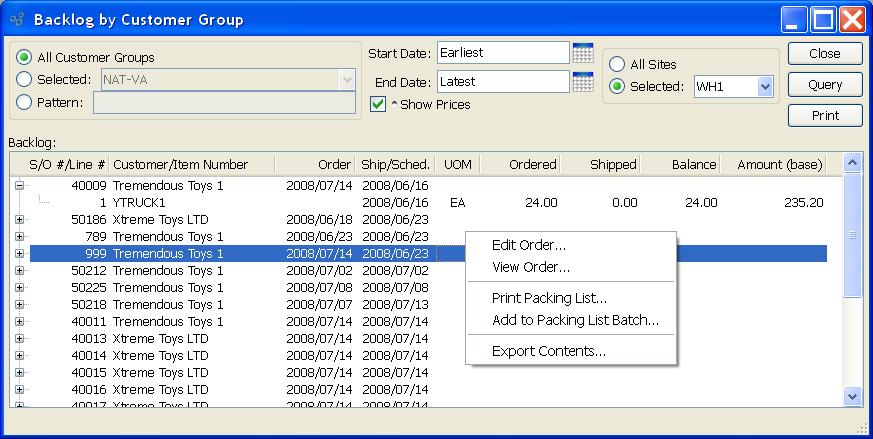
When displaying Backlog by Customer Group, you are presented with the following options:
- All Customer Groups
Select to display Backlog for all Customer Groups.
- Selected
Specify Customer Group whose Backlog you want to display.
- Pattern
Enter a Customer Group pattern to select a range of Customer Groups. Refine your search using Regular Expressions.
- Start Date
Backlog by Customer Group entered on and after this date will be displayed.
- End Date
Backlog by Customer Group entered on and before this date will be displayed.
- Show Prices
Select to include pricing information in the display.
- All Sites
Select to display Backlog by Customer Group for all Sites.
- Selected
Specify Site whose Backlog by Customer Group you want to display.
- Backlog
Display lists Backlog by Customer Group, using the specified parameters. This display is a nested list, with a plus ("+") sign located to the far left of the display next to each line that may be expanded to lower levels. By clicking your mouse on a plus sign, you reveal lower levels of information related to the Documents. If the "Show Prices" option is selected, an additional column showing the amount of the backlog, with Prices normalized to the Base Currency using the Currency Exchange Rate effective on the Order Date, will display. The total backlog will also be shown.
To the far right of the screen, the following buttons are available:
- CLOSE
Closes the screen, returning you to the application desktop.
- QUERY
Select to generate the display, using the specified parameters.
Runs the report associated with this screen.
Right-clicking on a Sales Order Line Item in the Backlog list enables you to select from the following menu options:
To view Backlog by Customer, select the "Backlog by Customer" option. The following screen will appear:
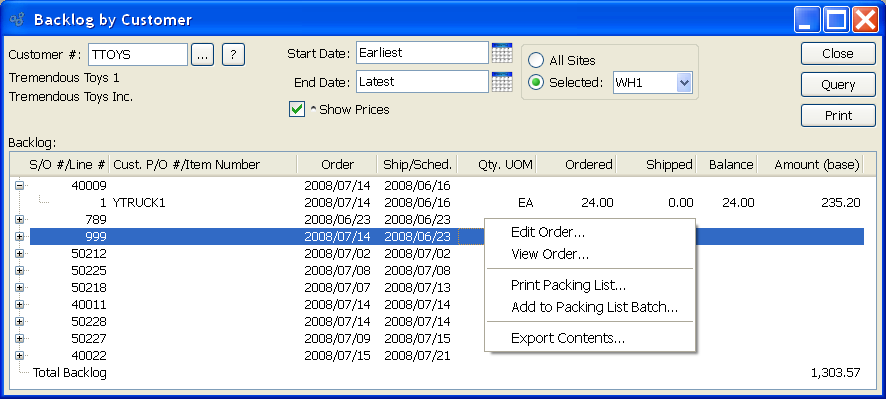
When displaying Backlog by Customer, you are presented with the following options:
- Customer #
Enter the Customer Number of the Customer whose Backlog you want to display. The browse button located to the right of the field leads to a searchable Customers list. You may also access this list using the keyboard shortcut "CTRL + L". Once a Customer Number is entered, the Customer name and billing address will display. Select the "?" or "$" symbol next to the browse button to view Customer information for the specified Customer. If a Customer's credit is "In Good Standing," the button will feature a black question mark ("?") icon. If the icon turns to an orange dollar sign ("$"), the Customer's credit Status is "On Credit Warning." A red dollar sign ("$") indicates the Customer's credit Status is "On Credit Hold."
- Start Date
Backlog by Customer entered on and after this date will be displayed.
- End Date
Backlog by Customer entered on and before this date will be displayed.
- Show Prices
Select to include pricing information in the display.
- All Sites
Select to display Backlog by Customer for all Sites.
- Selected
Specify Site whose Backlog by Customer you want to display.
- Backlog
Display lists Backlog by Customer, using the specified parameters. If the "Show Prices" option is selected, an additional column showing the amount of the backlog, with Prices normalized to the Base Currency using the Currency Exchange Rate effective on the Order Date, will display. The total backlog will also be shown.
To the far right of the screen, the following buttons are available:
- CLOSE
Closes the screen, returning you to the application desktop.
- QUERY
Select to generate the display, using the specified parameters.
Runs the report associated with this screen.
Right-clicking on a Sales Order Line Item in the Backlog list enables you to select from the following menu options:
To view Backlog by Sales Order, select the "Backlog by Sales Order" option. The following screen will appear:
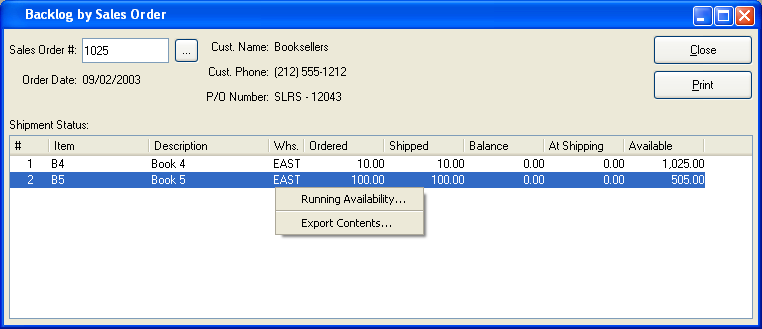
When displaying Backlog by Sales Order, you are presented with the following options:
- Sales Order #
Enter the Sales Order Number of the Sales Order whose backlog you want to view.
- Order Date
Displays the date the Sales Order was placed.
- Cust. Name
Displays the Customer name associated with specified Sales Order.
- Cust. Phone
Displays the Customer phone number associated with specified Sales Order.
- P/O Number
Displays the Customer Purchase Order number associated with specified Sales Order.
- Shipment Status
Display lists Backlog by Sales Order, using the specified parameters. If the available quantity falls below zero, the value will display in red type.
To the far right of the screen, the following buttons are available:
- CLOSE
Closes the screen, returning you to the application desktop.
Runs the report associated with this screen. Right-clicking on a Sales Order Line Item in the Shipment Status list enables you to select from the following menu options:
To view Backlog by Product Category, select the "Backlog by Product Category" option. The following screen will appear:
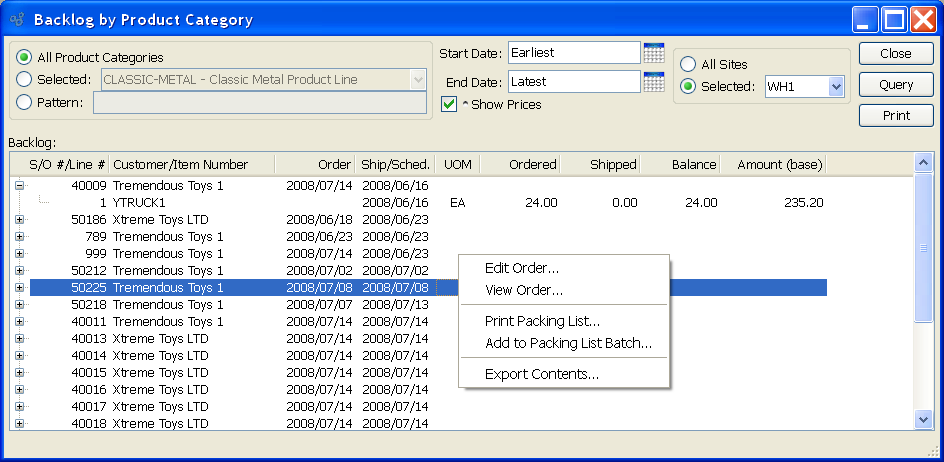
When displaying Backlog by Product Category, you are presented with the following options:
- All Product Categories
Select to display Backlog for all Product Categories.
- Selected
Specify Product Category whose Backlog you want to display.
- Pattern
Enter a Product Category pattern to select a range of Product Categories. Refine your search using Regular Expressions.
- Start Date
Backlog by Product Category entered on and after this date will be displayed.
- End Date
Backlog by Product Category entered on and before this date will be displayed.
- Show Prices
Select to include pricing information in the display.
- All Sites
Select to display Backlog by Product Category for all Sites.
- Selected
Specify Site whose Backlog by Product Category you want to display.
- Backlog
Display lists Backlog by Product Category, using the specified parameters. If the "Show Prices" option is selected, an additional column showing the amount of the backlog, with Prices normalized to the Base Currency using the Currency Exchange Rate effective on the Order Date, will display. The total backlog will also be shown.
To the far right of the screen, the following buttons are available:
- CLOSE
Closes the screen, returning you to the application desktop.
- QUERY
Select to generate the display, using the specified parameters.
Runs the report associated with this screen.
Right-clicking on a Sales Order Line Item in the Backlog list enables you to select from the following menu options:
To view Backlog by Item, select the "Backlog by Item" option. The following screen will appear:
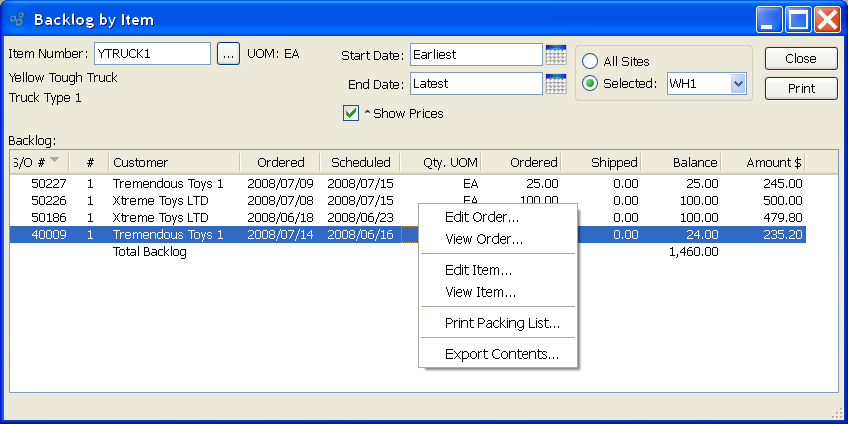
When displaying Backlog by Item, you are presented with the following options:
- Item Number
Enter the Item Number of the Item whose Backlog you want to view. The browse button located to the right of the field leads to a searchable list of make and buy items.
- UOM
Inventory Unit of Measure.
- Start Date
Backlog by Item entered on and after this date will be displayed.
- End Date
Backlog by Item entered on and before this date will be displayed.
- Show Prices
Select to include pricing information in the display.
- All Sites
Select to display Backlog by Item for all Sites.
- Selected
Specify Site whose Backlog by Item you want to display.
- Backlog
Display lists Backlog by Item, using the specified parameters. If the "Show Prices" option is selected, an additional column showing the amount of the backlog, with Prices normalized to the Base Currency using the Currency Exchange Rate effective on the Order Date, will display. The total backlog will also be shown.
To the far right of the screen, the following buttons are available:
- CLOSE
Closes the screen, returning you to the application desktop.
Runs the report associated with this screen.
Right-clicking on a Sales Order Line Item in the Backlog list enables you to select from the following menu options: